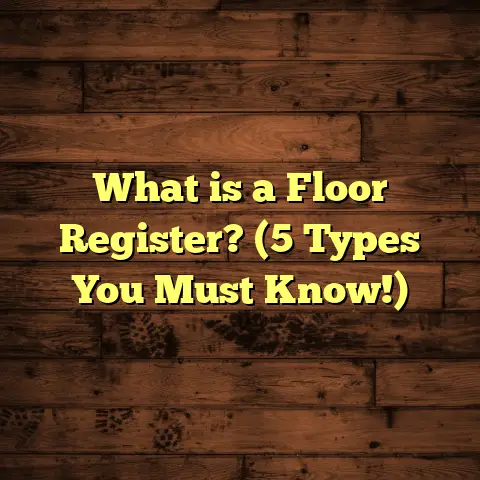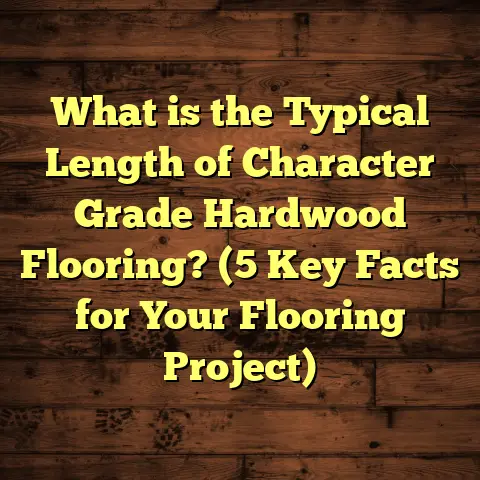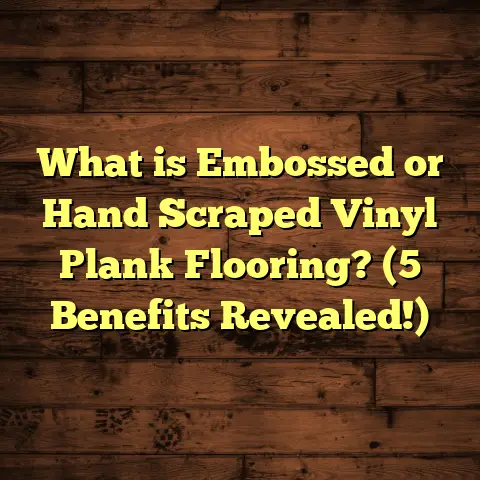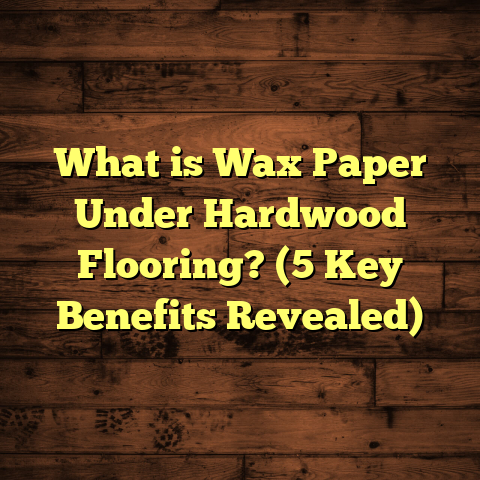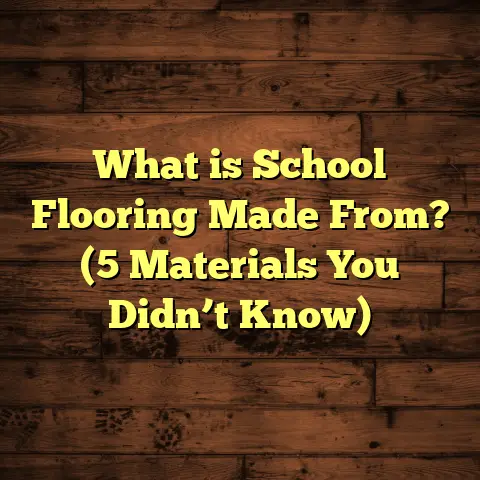What is a Barndominium Floor? (5 Key Features You Must Know)
“I never imagined a barn could feel so cozy and modern at the same time. The flooring really makes all the difference.” — A happy barndominium owner
That comment stuck with me for a long time. It’s amazing how something as simple as flooring can completely change the atmosphere of a space — especially in barndominiums. If you’ve been curious about these unique homes and their floors, you might be wondering: what exactly is a barndominium floor? How is it different from typical home flooring? And what should you know before you decide on one?
I want to share everything I’ve learned over years of working with barndominium projects. I’ll take you through the essentials, share real-life experiences, and back it up with data and case studies. By the end, you’ll have a clear picture of what makes barndominium floors special—and how to choose the perfect option for your own space.
What is a Barndominium Floor?
When someone asks me “what is a barndominium floor?” I like to keep it straightforward. A barndominium floor is the flooring system installed inside a barndominium — which is essentially a home built out of a metal barn or similar structure.
These floors serve two roles at once:
- They provide the comfort and aesthetics of a residential floor.
- They offer durability and resilience typical of barn or industrial-type flooring.
This combination is what sets barndominium floors apart from floors in conventional houses.
Why Are Barndominiums Different?
Barndominiums are a blend of living quarters and workspace or storage space. Imagine living areas next to where you keep tractors, ATVs, or woodworking tools. This hybrid use means your floor needs to be tough but livable.
Unlike traditional homes, barndominiums often use concrete slabs as the base floor instead of wood subfloors. This is because metal buildings typically don’t have crawl spaces or basements where you can install typical wood framing.
So understanding this mix of uses and building methods helps explain why barndominium floors are unique.
The 5 Key Features You Must Know About Barndominium Floors
I’ve learned through my work that five main features define quality barndominium floors. These are what you need to keep front and center when planning your project.
I’ll break down each feature in detail:
1. Durability: Floors That Stand Up to Heavy Use
One of my earliest barndominium clients was a farmer who wanted to park his tractor inside his home’s workshop area. Initially, he just poured a regular concrete slab and left it bare.
Within weeks, he was frustrated by dust, stains from oil drips, and cracks forming in spots where heavy equipment sat. Concrete itself is strong but not invincible.
This was my first real lesson in barndominium floors: durability isn’t just about strength; it’s about surface protection too.
What Makes Durability Crucial?
In a mixed-use home like this, floors face:
- Heavy machinery loads
- Constant foot traffic
- Vehicle tires rolling in and out
- Chemical spills (oil, paint thinner, fertilizers)
- Abrasive dirt and gravel tracked inside
In traditional homes, you might get away with hardwood or carpet because they only see foot traffic. Here, those materials would wear out quickly or become damaged beyond repair.
Top Durable Flooring Options
Over the years, I’ve seen what works best for durability:
- Concrete slab: The base for most barndominiums. When properly poured and cured, it’s extremely strong.
- Epoxy coatings: Applying an epoxy resin creates a chemical-resistant, scratch-proof surface. It bonds with concrete and forms a hard shell.
- Polyurea sealers: Similar to epoxy but with better UV resistance and flexibility.
- Polished concrete: Grinding and polishing the slab makes it smooth and reflective while improving toughness.
- Engineered hardwood with tough finishes: If you want wood looks but need better durability.
- Luxury vinyl plank (LVP): Water-resistant with wear layers designed to handle heavy foot traffic.
In fact, according to the National Floor Safety Institute’s 2023 report, floors coated with epoxy or polyurea reduce repair costs up to 40% over 5 years in industrial or mixed-use settings compared to untreated concrete.
My Experience With Durability Challenges
I recall a client who ran into serious issues when they chose unfinished hardwood over concrete in their barndominium’s garage section. The wood warped badly due to moisture and dents from dropped tools.
Switching them to epoxy-coated concrete saved them thousands in replacement costs within just one year.
2. Moisture Resistance: Protecting Floors From the Ground Up
Moisture has caused more headaches for barndominium owners than anything else I’ve seen.
Since these homes are often built on concrete slabs sitting directly on soil, moisture can travel through—warping wood floors or causing mold under flooring layers.
One project I worked on in Louisiana taught me this painfully. The client’s wooden floors started cupping severely within months due to high humidity and lack of vapor barriers.
Why Moisture is an Enemy
Moisture problems can lead to:
- Wood warping and swelling
- Mold growth under flooring layers
- Concrete slab deterioration (if not sealed)
- Unpleasant odors
- Reduced indoor air quality
The U.S. Department of Energy estimates that moisture intrusion in slab-on-grade homes contributes to 20% of building envelope failures nationwide.
How to Manage Moisture Effectively
Managing moisture involves several steps:
- Vapor barriers: These plastic sheets go under the slab during pouring to block moisture from rising.
- Proper grading and drainage: Ensures water flows away from your foundation.
- Sealing concrete: Epoxy or polyurethane sealers prevent water absorption.
- Choosing moisture-resistant materials: Vinyl planks, sealed tile, or treated engineered wood resist water better than solid hardwood.
- Installing dehumidifiers: In humid climates, these help keep indoor moisture manageable.
Case Study: Moisture Control Success
A client in Florida had recurring mold issues due to high humidity. After installing a vapor barrier under their slab and sealing their concrete floor with polyurea, they reported zero new mold growth over two years.
This shows how crucial moisture control is for floor longevity in barndominiums.
3. Ease of Maintenance & Cleaning: Floors You Can Live With
Let’s be honest: cleaning barn-style living spaces can be a pain if your floors aren’t designed for it.
I often get asked by clients, “What floor will make my life easier?” Especially for those who work with animals, vehicles, or messy hobbies inside their homes.
The answer? Floors that resist dirt and stains, and clean up fast.
Why Maintenance Matters More Here
Barndominiums tend to see:
- Dirt tracked inside from outdoor work or animals
- Spills of oils, paints, or other chemicals
- Dust from barn activities
- Heavy foot traffic
Floors that trap dirt or stain easily become eyesores quickly.
Flooring Options That Save Time & Effort
From my experience:
- Epoxy-coated concrete floors wipe clean quickly and resist stains.
- Vinyl plank flooring is waterproof and easy to mop.
- Tile is durable but grout lines need occasional scrubbing.
- Sealed hardwood requires regular maintenance but can look great if cared for.
A client I worked with who had horses indoors said epoxy floors cut her cleaning time in half compared to untreated concrete.
Tips for Easy Floor Maintenance
- Sweep or vacuum regularly to remove dirt before it scratches surfaces.
- Use mild cleaners suitable for your floor type.
- Immediately clean spills to avoid staining.
- Consider rugs or mats in entryways to trap dirt early.
4. Combining Comfort with Functionality
When people think “barndominium,” they imagine rugged practicality first. But many want cozy living spaces where comfort matters just as much as toughness.
I’ve had clients tell me that upgrading their bare concrete floors transformed their homes from cold workshops into inviting living spaces.
Why Comfort Shouldn’t Be Overlooked
Standing on hard concrete all day can be exhausting. Some floors feel cold underfoot during winter months. Noise echoes off hard surfaces too much.
Comfort factors include:
- Floor temperature
- Surface texture (smooth vs rough)
- Cushioning or softness underfoot
- Sound absorption properties
How to Make Floors More Comfortable
Radiant floor heating beneath concrete slabs is a popular solution. It warms the floor evenly without losing durability.
Adding area rugs or anti-fatigue mats in standing areas softens the feel without compromising function.
Vinyl planks layered over concrete offer slight cushioning while maintaining water resistance.
5. Style & Design Flexibility: Rustic Meets Modern
Barndominiums don’t have to be all barn and no style. Many owners want floors that express personality while fitting the rustic-meets-modern aesthetic.
From stained concrete with decorative patterns to wood-look vinyl planks, there are tons of options.
Why Style Matters
Your floor sets the tone for your entire home — it affects mood, resale value, and how much you enjoy your space daily.
A study by Houzz found that 72% of homeowners consider flooring style among their top 3 renovation priorities.
Popular Flooring Styles in Barndominiums
- Stained or dyed concrete: Affordable artistic expression.
- Wood-look vinyl or laminate: Combines warmth with ease of care.
- Mixed materials: Tile in wet areas plus wood or vinyl elsewhere.
- Matte finishes: Hide scratches and dirt better than glossy surfaces.
One client loved the industrial look of exposed concrete but added warmth with reclaimed wood planks in living areas—creating contrast and coziness.
Diving Deeper: Additional Insights From My Projects
Throughout dozens of barndominium builds, I’ve noticed some patterns worth sharing that will help you avoid common mistakes:
Subfloor Preparation Is Everything
Many problems stem from poor subfloor preparation before finishing materials go down.
Concrete slabs must be:
- Properly poured with control joints
- Fully cured (usually 28 days)
- Smooth and level (or prepped by grinding)
- Clean and dry before coatings or coverings
Rushing this process leads to cracks, bubbles in epoxy coatings, or uneven floors that cause tripping hazards.
Budgeting for Flooring Costs
Many clients underestimate flooring costs when planning their barndominium budgets.
Here’s what I typically see:
| Flooring Type | Average Cost per Sq Ft (Materials + Installation) |
|---|---|
| Bare Concrete | $2 – $4 |
| Epoxy Coated Concrete | $7 – $12 |
| Polished Concrete | $5 – $10 |
| Engineered Hardwood | $7 – $15 |
| Luxury Vinyl Plank | $4 – $9 |
| Tile | $6 – $15 |
Remember: investing upfront in quality materials saves money on repairs down the line.
Case Study: Balancing Budget & Performance
A couple building a 2,500 sq ft barndominium wanted durability but had budget constraints. We recommended polished concrete for main areas ($7/sq ft) plus vinyl plank for bedrooms ($5/sq ft).
Total flooring cost came around $18,000—within their budget—and they got both toughness and comfort.
My Personal Take on Barndominium Floors
I’ve been installing floors in these unique homes for over seven years now. Each project taught me something new about balancing toughness with livability.
One thing became clear: there’s no one-size-fits-all answer. Your lifestyle dictates your best choice.
If you’re heavy into farming or mechanical work inside your home, epoxy-coated concrete is likely your friend. If you want warmth for family spaces but still need durability elsewhere, mixing materials works well.
Moisture control always comes first; ignoring it will cost you dearly later on with repairs and replacements.
Comfort matters more than most expect—adding radiant heat or soft mats makes daily life easier without sacrificing ruggedness.
Finally, don’t neglect design! Your floor should make you smile every time you walk into your barndo.
Questions You Might Have
Q: Can I install hardwood over a concrete slab?
A: Yes—but moisture barriers are essential. Engineered hardwood is usually better than solid wood because it handles moisture fluctuations better.
Q: How long does an epoxy floor last?
A: With proper prep and maintenance, epoxy coatings can last 10–15 years before needing reapplication.
Q: What about radiant heat under concrete?
A: It’s highly effective and becoming common in barndominiums to add comfort without losing durability.
Q: Are there eco-friendly flooring options?
A: Yes—bamboo engineered wood or recycled vinyl planks are greener choices worth exploring.
Wrapping Up My Thoughts on Barndominium Floors
Barndominium floors are fascinating because they walk two paths simultaneously—tough barn floor meets cozy home surface. When planned right, they hold up beautifully through heavy use while keeping your space welcoming and stylish.
If you’re building or remodeling one of these homes, take time to explore durable materials, manage moisture carefully, focus on easy maintenance, add comfort where you can, and pick styles that make your heart happy.
Want advice tailored exactly to your project? Just ask—I’m here to help!
